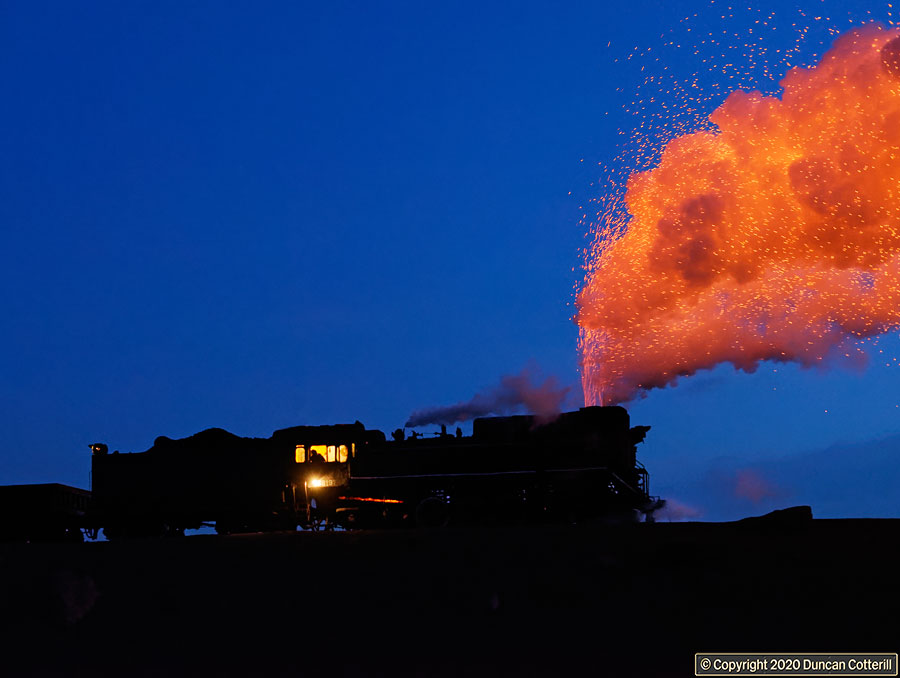SANDAOLING SOLDIERS ON
defying expectations, steam survived to work another winter at Sandaoling
China - 21 November to 10 December 2019 - Report by Duncan Cotterill
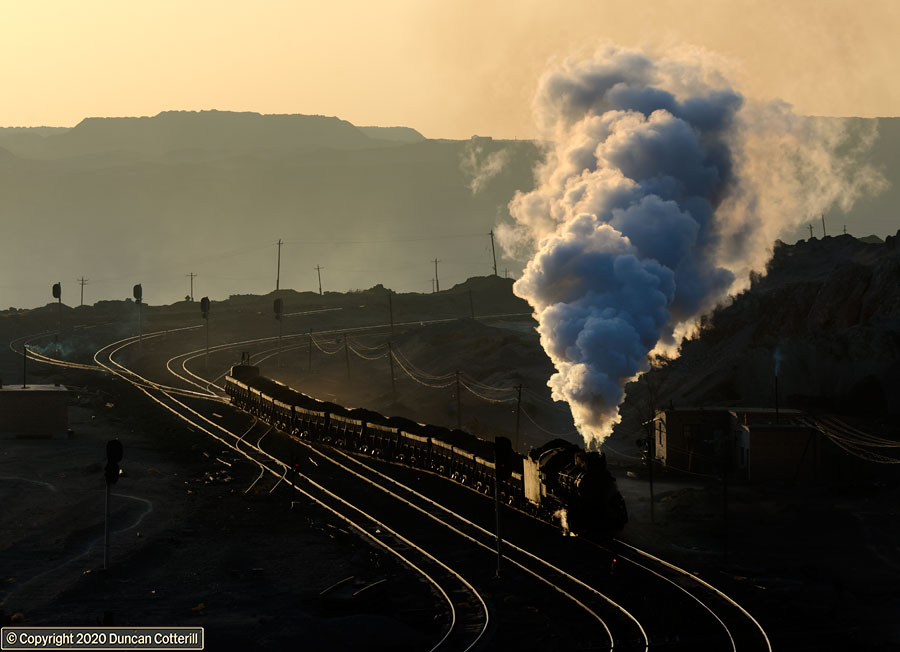
Catching The Light
JS 8190 rattled through Be'erzhan with a loaded train as the sun dropped towards the horizon on the afternoon of 29 November 2019. Even the most filthy unkempt engine reflects some light in conditions like these.INTRODUCTION
As 2019 progressed, it became clear that Sandaoling would still be using steam for another winter season. It seemed churlish not to support the local hotels and restaurants with our custom, so a trip to Xinjiang was arranged. Apart from a day in Beijing on the way out and a couple of days there on the way back, the whole time was spent at Sandaoling, from lunchtime on Sunday 24 November to lunchtime on Saturday 7 December.OPENCAST MINE OPERATIONS
Apart from a couple of typically unproductive hours at Beiquan Erjing, we spent all our time on the opencast system.Locos
We saw four different locos in steam during our visit, JS 8167, 8190, 8197 and 8225. Three locos were kept in steam at any one time. When we arrived, JS 8167, 8190 and 8197 were in use. As previously reported, one loco is changed over on Thursday evenings. JS 8225 replaced JS 8197 on the first Thursday and JS 8197 replaced JS 8167 on the second.JS 8197 had recently been repainted, something I never thought I’d see at Sandaoling again. JS 8167 and JS.8225 were also fairly clean compared to recent years. Only JS8190 was really grimy.
Smartened Up
A remarkably clean and freshly painted JS.8197 basked in the sun at Dongbolizhan on 6 December 2019.The washery was unable to take any coal until lunchtime on that date so no trains ran in the morning and the loco's crew took the opportunity to do some running repairs while they waited for operations to get back to normal.
Despite the late start, there were still 6 loaded trains out of the pit before sunset.
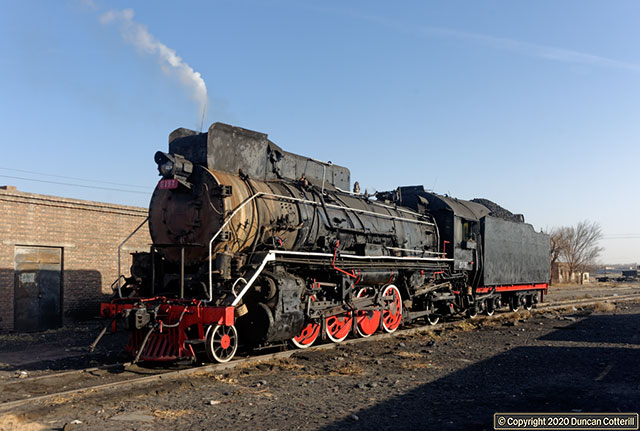
One evening, JS.8167 was seen between the works and the store, coupled to JS 8173, which wasn't in steam, and appeared to be being taken out of the store. We didn’t visit the works or the store so can’t confirm which locos were in either place, apart from JS 8384, the remains of which are still derelict in the usual place in the works compound.
The working locos appeared to be in reasonable mechanical condition but they weren’t being worked quite as hard as in previous years. Slipping seemed to be more common as well, particularly on the curve below Dongkengkou.
The working locos appeared to be in reasonable mechanical condition but they weren’t being worked quite as hard as in previous years. Slipping seemed to be more common as well, particularly on the curve below Dongkengkou.
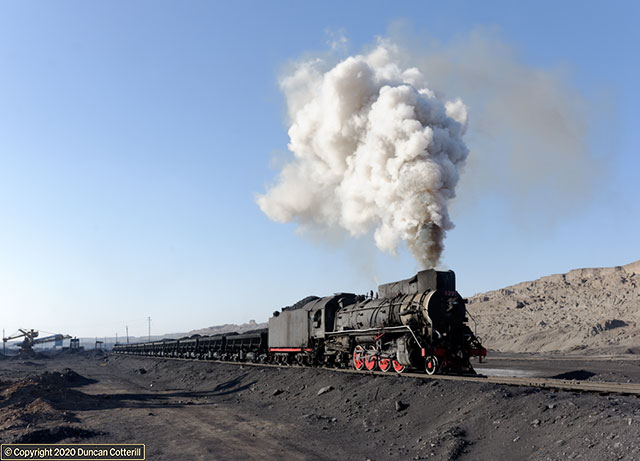
Powering Away
JS 8225 got into its stride as it left the blue loader at Xikeng with another load of coal for the Xuanmeichang 'washery' on 30 November 2019.During our stay at Sandaoling, 80% of trains ran from the blue loader to Xuanmeichang. Most of the remainder were loaded by shovels (front-end loaders) from a huge pile of coal, hidden behind the train in this photo.
Some coal was also loaded into lorries in the area to the left of this picture and presumably taken to Yijing for loading into CNR wagons.
Traffic
Traffic varied considerably from day to day. The best day saw 11 loaded trains out of the pit between 10:00 and 18:00, the worst day only 3. There were four quiet days, two due to problems with the blue loader and two due to problems with the washery. The remaining days saw an average of 8 loaded trains out of the pit between 10:00 and 18:00.Dongbolizhan Shift Change
With only three trains in use at any one time, there was less need for trains to shunt during the morning shift change, making it more difficult to get something original. That was particularly true when there were a dozen photographers trying to photograph two engines.There were opportunities but you had to be in the right place at the right time and hope the ugly pole on the right was at least partially hidden by steam.
With a fresh crew in charge, JS 8167 set off to take water on the morning of 29 November 2019, passing a resting JS 8225.
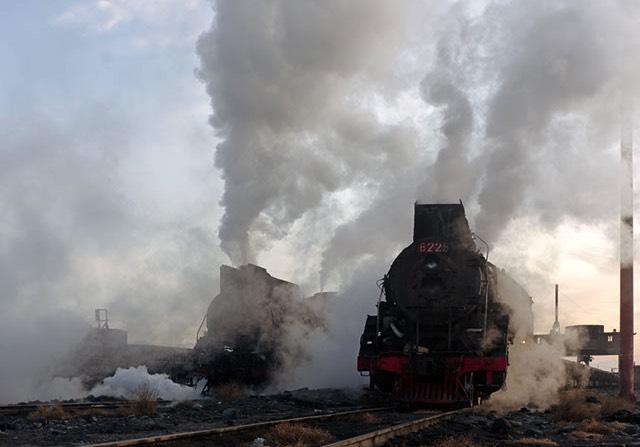
Of the 90 loaded trains we saw during our visit, all ran from Xikeng to Xuanmeichang (washery). Of these, 72 were loaded at the blue loader and the remaining 18 were loaded by shovels (front end loaders) in Xikeng yard. As last year, only the middle two tracks were in use, with the southern line used by all trains to and from the blue loader. The southern line was also used to coal locos when required and to load a couple of trains by shovel as well. Most shovel loading took place on the northern line from a huge pile of coal adjacent to the track.
We weren't aware of any trains running to the alternative unloading point at Jianmeixian, between the works and Nanzhan.
We weren't aware of any trains running to the alternative unloading point at Jianmeixian, between the works and Nanzhan.
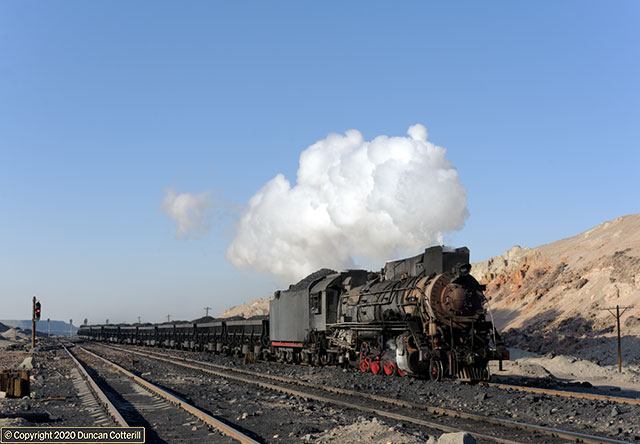
Ba’erzhan Bottleneck
JS 8190 swung through the pointwork at Ba’erzhan with a loaded train on the morning of 1 December 2019.The current method of operation involves empty trains waiting on the other side of Ba'erzhan until the loaded train has passed. This means that from one train leaving, it takes around 15 minutes before the next one is ready to start loading. There are two tracks that can access the loader but for some reason only one is used these days, preventing the empties from waiting close to the loader and adding about 10 minutes to the minimum time between departures.
Most of the time there were two trains in use with the third spare at Dongbolizhan. The main factor that governed the amount of traffic was the rate of loading at Xikeng. There was no real advantage in using a third train unless there was simultaneous loading at the blue loader and by shovel.
A loaded train could almost always get from the blue loader to Xuanmeichang, unload and get back to the holding position at Ba'erzhan before the next loaded train was ready to leave the loader. If there were three trains in use there was a good chance that they would just get in each other's way, impeding the smooth operation that seemed to be the norm with two trains in service.
On a few days there was also a departmental working, taking a couple of flatcars loaded with equipment into or out of the pit. These were powered by the engine that would otherwise have been spare at Dongbolizhan.
A loaded train could almost always get from the blue loader to Xuanmeichang, unload and get back to the holding position at Ba'erzhan before the next loaded train was ready to leave the loader. If there were three trains in use there was a good chance that they would just get in each other's way, impeding the smooth operation that seemed to be the norm with two trains in service.
On a few days there was also a departmental working, taking a couple of flatcars loaded with equipment into or out of the pit. These were powered by the engine that would otherwise have been spare at Dongbolizhan.
Xuanmeichang Sunset
JS 8225 pushed out of the loop at Xuanmeichang with a set of empties as the sun set on the evening of 30 November 2019.Despite the train being empty, the loco would still have to work hard to shove it up the short steep bank to Kengkouzhan. From there gravity would take over and deliver the train to the holding point, just short of Ba'erzhan, without any more effort from the loco.
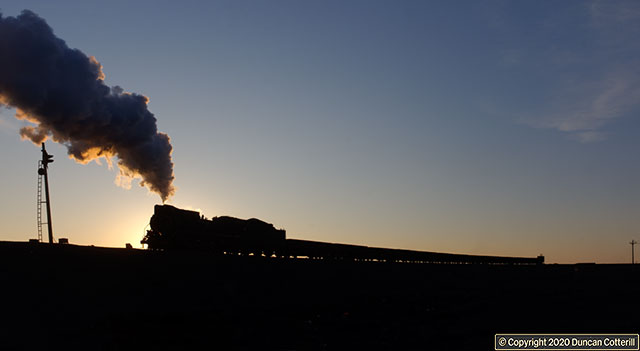
Shift change still took place at Dongbolizhan between 08:30 and 09:30 every morning but the pattern of workings beforehand was different to previous years. The “passenger” engine had always left Dongbolizhan well before 08:15 and would wait for its passenger(s) at Kengkouzhan before departing for Ba’erzhan around 08:30. It would usually arrive back at Dongbolizhan between 08:50 and 09:00.
On several days there were no locos in the usual positions at Dongbolizhan when we arrived about 08:20. The empty trains from Xuanmeichang to Dongbolizhan appeared to run later than in previous years with the last arrival often after 09:00. On a number of occasions we saw a train leaving the washery or at Kengkouzhan around 08:10 and a second leaving the washery between 08:15 and 08:30.
The first of the two empty trains would sometimes wait for its new crew opposite the offices at the eastern entrance to Dongbolizhan yard then pull into the sidings around 08:45. The second almost always waited until the passenger engine returned before leaving Kengkouzhan, arriving at Dongbolizhan around 09:00 to 09:05.
On several days there were no locos in the usual positions at Dongbolizhan when we arrived about 08:20. The empty trains from Xuanmeichang to Dongbolizhan appeared to run later than in previous years with the last arrival often after 09:00. On a number of occasions we saw a train leaving the washery or at Kengkouzhan around 08:10 and a second leaving the washery between 08:15 and 08:30.
The first of the two empty trains would sometimes wait for its new crew opposite the offices at the eastern entrance to Dongbolizhan yard then pull into the sidings around 08:45. The second almost always waited until the passenger engine returned before leaving Kengkouzhan, arriving at Dongbolizhan around 09:00 to 09:05.
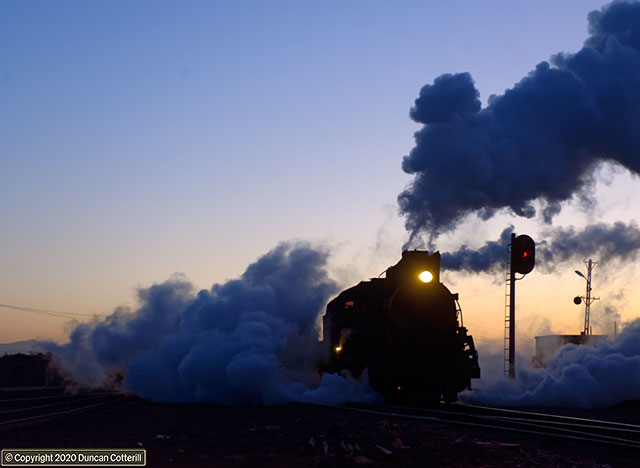
Early Morning Arrival
After waiting at the eastern throat of Dongbolizhan Yard for a new crew, JS.8190 restarted its train and eased into the sidings at 08:40 on the morning of 2 December 2019.One of the pleasures of returning to Sandaoling year after year is that there's usually something different to photograph each time. This year it was the later arrivals for the morning shift change at Dongbolizhan.
For some reason, we were rarely joined by anyone else for these arrivals, despite the potential for good pictures.
The first departure from Dongbolizhan would usually be between 09:15 and 09:45 and the first loaded train out of the pit would usually run sometime between 10:30 and 11:00 but was much later on a couple of days.
When things were running smoothly there would usually be around four trains out of the pit before the blue loader took a lunch break from 13:30 to 15:00, then four more before sunset at approximately 18:00.
Loading by shovel would sometimes continue through the lunchtime period but almost always finished around 16:00. The time to load a train by shovel varied according to how many shovels were being used. A single shovel could take almost 2 hours but when three were in use, 40 minutes was possible. The massive electric shovel that used to load trains in double quick time was still at Xikeng but out of use and looking rather forlorn.
When things were running smoothly there would usually be around four trains out of the pit before the blue loader took a lunch break from 13:30 to 15:00, then four more before sunset at approximately 18:00.
Loading by shovel would sometimes continue through the lunchtime period but almost always finished around 16:00. The time to load a train by shovel varied according to how many shovels were being used. A single shovel could take almost 2 hours but when three were in use, 40 minutes was possible. The massive electric shovel that used to load trains in double quick time was still at Xikeng but out of use and looking rather forlorn.
Pushing Back
JS 8190 caught the morning light as it shoved the first rake of empties out of Dongbolizhan at 09:44 on 7 December 2019.Departing empties faced a short but steep climb on a curve before cresting the summit at Kengkouzhan and the rails were often slippery. Despite its vigorous departure, the loco came close to stalling before it reached the top.
Just another day on one of China's many industrial railways or a sight worth travelling a third of the way round the world to experience? I know what I think!
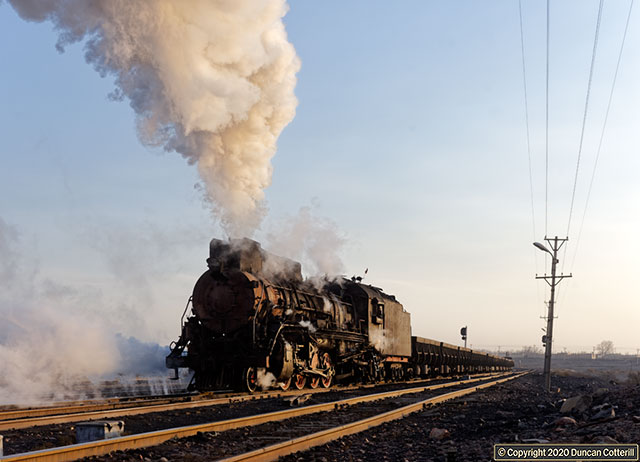
DEEP MINE SYSTEM (Nanzhan)
We saw very little of the Nanzhan system during our visit. Both Erjing and the loading point at Yijing are still in use judging by the shiny rails, and a train seen in the distance near Yijing on one occasion. Multiple trails of steam were seen around Nanzhan, again, from a distance, and a few DF8B hauled trains to/from Shadunzi were seen from Dongbolizhan, indicating little, if any, change. The only loco positively identified was JS 8089, seen near the works one evening, prompting a panic from the Stasi when I walked out of their sight, under the bridge, to see what it was.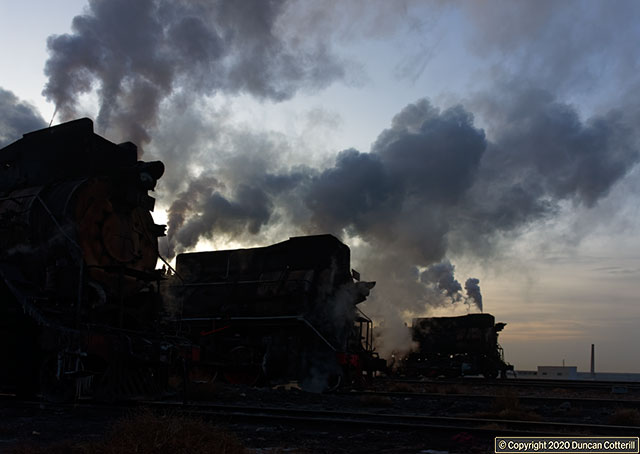
Three of a Kind
JS 8167 (nearest the camera) and JS 8225 were in attendance at the morning shift change at Dongbolizhan on 29 November 2019, while JS 8190 trundled past on its way back from performing the passenger duty.Note the centrally positioned headlight on JS 8225. Most opencast locos had their headlights re-positioned above the smokebox door in the days when most trains were propelled by chimney first locos. JS 8225 was unique amongst recent opencast locos in retaining its centrally positioned headlight.
Security
Unsurprisingly, security was even tighter than last year, continuing the expected trend. As well as being checked at Hami airport (fairly painless and extremely friendly) and on first entering Sandaoling (more involved but not a problem) we were tailed everywhere we went. Unmarked police cars followed us every day, from the hotel to Dongbolizhan, to the pit, to any restaurants we visited and back to the hotel at night. They were obviously trying to keep out of sight but failed miserably. The giveaway was that all the cars were white VW Santanas, most of them with no licence plates, which made them as inconspicuous as a man in a clown suit at a funeral. We didn’t have any hassle from them and they provided hours of entertainment, playing Spot the Stasi! We were even followed most of the way to Hami when we returned to the airport for our flight back to Beijing.First Train Out
JS 8225 rounded the curve at Dongkengkou with the first loaded train of the day on 5 December 2019.This was one of the last places in the pit to get the morning sun and was usually in partial shadow when the day's first train ran. Even in the dry desert conditions there was enough moisture in the air to make the rails slippery in such places and we saw several trains lose adhesion at this spot.
JS 8225 was going well and made it to the top without incident on this occasion.
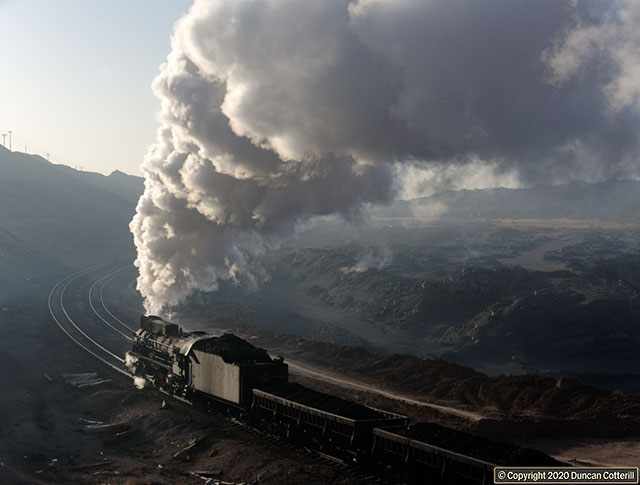
There is now a police checkpoint between Sandaoling town and the opencast pit. It seemed to be a semi-automated sort of affair that checked the vehicle numberplate and did a facial recognition of the driver but there were no checks of passengers or of pedestrians or cyclists. That might not apply to foreign pedestrians or cyclists though. A similar checkpoint has also been built on the road leading from the town towards the Beiquan mines.
As last year, the biggest problem with security for visitors to the mine is likely to be one of language when going through the various security checks. We had a native Chinese speaker with us and would have struggled without her.
As last year, the biggest problem with security for visitors to the mine is likely to be one of language when going through the various security checks. We had a native Chinese speaker with us and would have struggled without her.
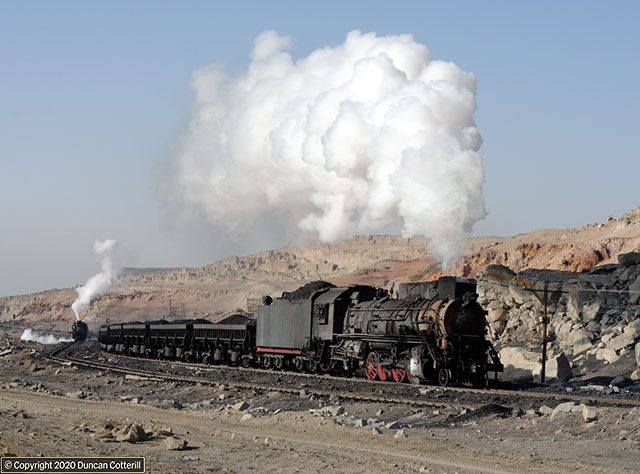
On the Corner
JS 8190 accelerated its loaded train away from Ba'erzhan on 4 December 2019. In the distance, JS 8167 got its train of empties moving and headed for the loader.This is one of my favourite locations in the pit, so no apologies for including a picture at this spot in almost all of my Sandaoling reports.
The red rocks in the background, the low telegraph poles that don't grow out of the chimney, the outside curve that holds the light from early morning to sunset and the second train that's often visible in the distance all combine to produce a very attractive place to photograph trains.
Weather
After last year’s cloud and haze, the weather returned to normal this year with plenty of clear sunny days and good views of the Tianshan. Early in our visit there were a few cloudy periods and days when the visibility wasn't brilliant but the weather was excellent most of the time.Temperatures were low enough to ensure good exhausts all day, every day but it was never uncomfortably cold, even before dawn at Dongbolizhan.
Crossing Point
JS 8167 powered away from Ba'erzhan towards Kengkouzhan with a loaded train on 30 November 2019, passing JS 8225, waiting patiently for the signal to push back under the Xikeng loader.And so the cycle continues, day and night, all year round, only punctuated by breakdowns, holidays and the vagaries of the coal market.
One day in the not too distant future it will all stop. Fires will be dropped, air pumps will fall silent and the age of steam worked railways will come to an end after around 200 years.
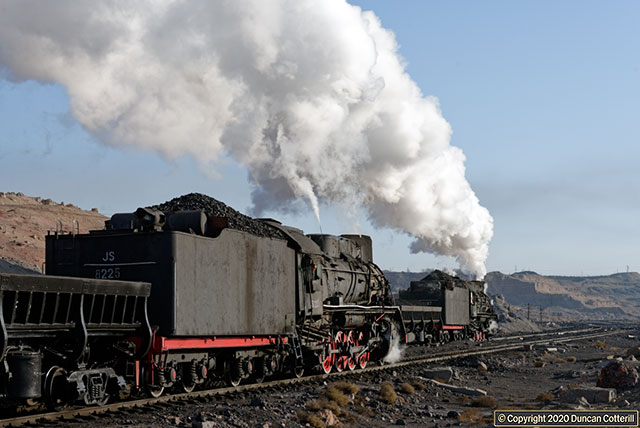
BEIJING
We had three full days in Beijing, Saturday 23 November, Sunday 8 and Monday 9 December.On the first day the weather was poor so we took a taxi to the railway bookshop, now at 8 Youanmenxi Jie (北京市西城区右安门西街8号), south west of the city centre. The bookshop's website indicated that it was open on Saturdays but when we got there, we found that only applied in summer. A short lunchtime visit to the Dongnan Jialou (北京市东城区崇文门东大街9号), overlooking Beijing station, revealed nothing new with Class HXD3D electrics on most trains and a few locos of classes HXD3C, HXD1D, SS9G, DF4D and DF7C also in evidence.
A visit to the Summer Palace on the second day was unlikely to include anything of railway interest but did involve a lot of travel on the Beijing Metro. The journey from Beijing Zhan to Beigongmen was all on conventional underground lines but returning from Yiheyuanximen we discovered that the Western Suburban Line was an above ground tramway style operation with modern Chinese built vehicles running on segregated track.
The third day promised slightly better weather so it was off to the Dongnan Jialou fairly early. The traction on view was was generally similar to that seen on the first visit but there were also a couple of very long green streamlined EMUs of classes FXD1 and FXD3, which appeared to have arrived on overnight trains from Shanghai. The difference between the two types wasn't obvious and they both appeared to have power cars sandwiching sleeper and conventional seating coaches. There were probably catering vehicles as well but they didn't register. One of the units worked a fill-in turn to Qinhuangdao at the time of the train that had previously been a regular DF11Z turn.
We visited the railway bookshop again and found it open this time. There were no new enthusiast orientated books on sale although they still had many of the older titles in stock.
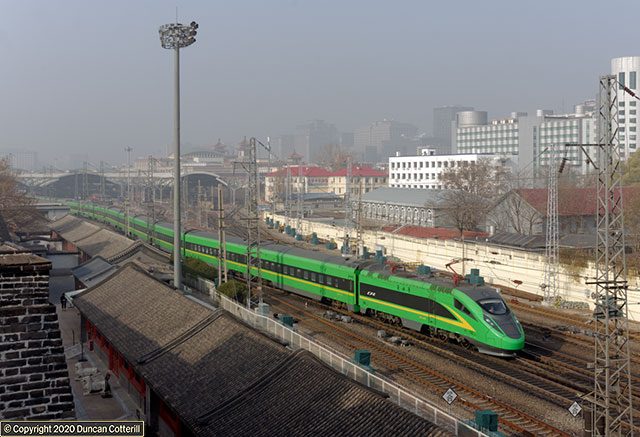
Green Mamba
An FXD3 EMU slithered out of Beijing station towards the carriage sidings on the morning of 9 December 2019. The unit appeared to have arrived on an overnight train from Shanghai that would have been hauled by a DF11G double unit diesel a few years ago, then by a modern electric loco more recently. Now it's an EMU.It's difficult to keep up with the dizzying rate of change on China's railways, which have gone from being mainly steam worked to having the world's largest high speed network in around 30 years.
TRAVEL ARRANGEMENTS
Flights from London to Beijing and back were with Lufthansa, via München on the way out and Frankfurt on the way back. On the outward leg we stayed in Beijing for two nights before continuing by air to Hami with Air China on the morning of 24 November.While at Sandaoling we stayed at the Longmen Hotel, as we have for the past few years, and had the services of our usual driver.
On the way back we took Air China's afternoon flight from Hami to Beijing on 7 December. Fortunately there were no military exercises or bad weather to disrupt the journey this year. Instead of staying near Capital Airport, we took the airport bus into town and stayed at the Paragon Hotel near the station for 3 nights.
It's worth mentioning that Beijing now has two major airports with Daxing, south of the city, opening in late 2019. At the time of our visit, Lufthansa were still using Capital Airport as were most Air China flights, including those to Hami, but that could change, so best to check before you go. Getting from one airport to the other looks far from straightforward.
Rain of Fire
JS 8197 was in a very sparky mood as it pushed the night's last set of empties away from Xuanmeichang just before dawn on 7 December 2019.It appears that the crew were cleaning the fire prior to handing the loco over to a new crew once they reached Kengkouzhan. Whatever the cause, the result was spectacular and unlike anything I've seen before at Sandaoling.
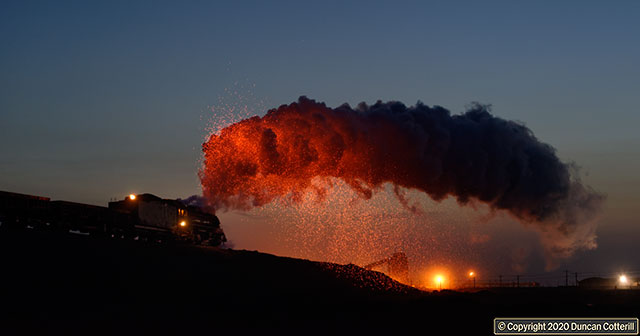
COMMENTS AND CONCLUSIONS
After 11 trips to Sandaoling, I didn't know whether I'd want to go back again at the end of 2019. The 2018 trip had been a bit disappointing, with low traffic levels, poor weather and nothing new to photograph. I didn't realise just how poor it was until I came to write up the report and struggled to find enough good pictures to illustrate it. Fortunately the pull of steam is strong and, as the year progressed, it became clear that steam would survive in the opencast for another winter. Going was a good decision, rewarded with excellent light and some new photo opportunities.Whether a late 2020 trip will be possible is very much up in the air as this is written in March 2020. China is currently closed to foreigners due to the risk of coronavirus, there are very few flights to anywhere and Boris has imprisoned me in my own house. The security situation in Xinjiang doesn't seem to be getting easier and the economic slowdown caused by the virus will inevitably have its impact on the Chinese coal industry. Marginal operations like the opencast at Sandaoling are likely to suffer the most if China's demand for coal reduces.
As usual, we spoke to several people about future plans for the steam operation at Sandaoling but didn't get a clear picture. For every person who said it was safe for another couple of years, there was someone else who thought it would be lucky to survive beyond early 2020. And that was before the current difficulties.
Even if the opencast does survive, it won't necessarily use the railway to take coal out of the pit. There was evidence of a new road being built from the loading area at Xikeng towards Kengkouzhan, paralleling the railway at first then striking off to the north before petering out. Exactly how it would exit the pit wasn't obvious but it didn't look straightforward. There was no sign of construction work being carried out on the road during our visit.
Like last year, I'm far from confident about getting back to Sandaoling at the end of 2020, even if steam survives. Security gets tighter and more of a hassle every year and who knows what restrictions will be in place after the coronavirus panic is over, if it is actually over by then. At the moment it feels like this might well have been my last trip to Sandaoling and quite possibly my last trip to see real working steam anywhere.
I normally finish off these reports by saying go while you can, before it's too late, but this time it probably is too late.
If that is the case then it was a good way to end 45 years of chasing steam locomotives around the world.
